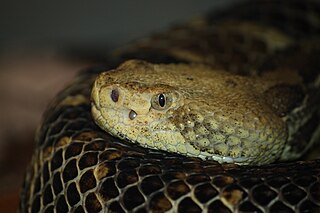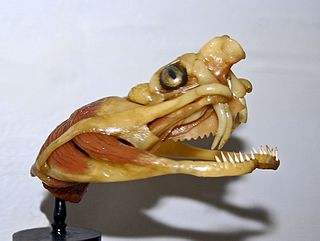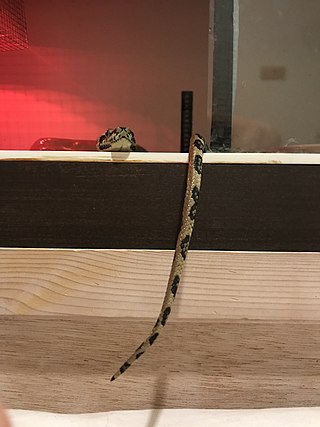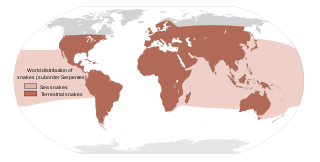
The Crotalinae, commonly known as pit vipers, or pit adders, are a subfamily of vipers found in Asia and the Americas. Like all other vipers, they are venomous. They are distinguished by the presence of a heat-sensing pit organ located between the eye and the nostril on both sides of the head. Currently, 23 genera and 155 species are recognized: These are also the only viperids found in the Americas. The groups of snakes represented here include rattlesnakes, lanceheads, and Asian pit vipers. The type genus for this subfamily is Crotalus, of which the type species is the timber rattlesnake, C. horridus.

The Viperidae (vipers) are a family of snakes found in most parts of the world, except for Antarctica, Australia, Hawaii, Madagascar, New Zealand, Ireland, and various other isolated islands. They are venomous and have long, hinged fangs that permit deep penetration and injection of their venom. Three subfamilies are currently recognized. They are also known as viperids. The name "viper" is derived from the Latin word vipera, -ae, also meaning viper, possibly from vivus ("living") and parere, referring to the trait viviparity common in vipers like most of the species of Boidae.

A snakebite is an injury caused by the bite of a snake, especially a venomous snake. A common sign of a bite from a venomous snake is the presence of two puncture wounds from the animal's fangs. Sometimes venom injection from the bite may occur. This may result in redness, swelling, and severe pain at the area, which may take up to an hour to appear. Vomiting, blurred vision, tingling of the limbs, and sweating may result. Most bites are on the hands, arms, or legs. Fear following a bite is common with symptoms of a racing heart and feeling faint. The venom may cause bleeding, kidney failure, a severe allergic reaction, tissue death around the bite, or breathing problems. Bites may result in the loss of a limb or other chronic problems or even death.

Keeled scales refer to reptile scales that, rather than being smooth, have a ridge down the center that may or may not extend to the tip of the scale, making them rough to the touch. According to Street's (1979) description of European lizards and snakes, in those that have keeled scales the keels are usually stronger in male specimens and are consistently arranged according to the species of reptiles, even though many others do not have them. With European lizards, the dorsal scales are usually well keeled, while those on the flanks are more weakly keeled and those on the belly smooth. Non-European lizards such as Sphaerodactylus macrolepis also display keeled scales.

Snake venom is a highly toxic saliva containing zootoxins that facilitates in the immobilization and digestion of prey. This also provides defense against threats. Snake venom is injected by unique fangs during a bite, whereas some species are also able to spit venom.

Nigel Alan Marven is a British wildlife TV presenter, naturalist, conservationist, author, and television producer. He is best known as presenter of the BBC miniseries Chased by Dinosaurs, its sequel, Sea Monsters, as well as the ITV miniseries Prehistoric Park. He is also known for his unorthodox, spontaneous, and daring style of presenting wildlife documentaries as well as for including factual knowledge in the proceedings.

Caudal luring is a form of aggressive mimicry characterized by the waving or wriggling of the predator's tail to attract prey. This movement attracts small animals who mistake the tail for a small worm or other small animal. When the animal approaches to prey on the worm-like tail, the predator will strike. This behavior has been recorded in snakes, sharks, and eels.
Deadly... is a strand of British wildlife documentary programming aimed principally at children and young people, which is broadcast on CBBC on BBC One and Two and on the CBBC Channel. It is presented by Steve Backshall, with Naomi Wilkinson as co-host on Live 'n Deadly, and Barney Harwood as co-host on Natural Born Hunters. The strand began with a single series known as Deadly 60, and has subsequently expanded into a number of spin-offs, re-edits and follow-up versions.

Most snakebites are caused by non-venomous snakes. Of the roughly 3,700 known species of snake found worldwide, only 15% are considered dangerous to humans. Snakes are found on every continent except Antarctica. There are two major families of venomous snakes, Elapidae and Viperidae. 325 species in 61 genera are recognized in the family Elapidae and 224 species in 22 genera are recognized in the family Viperidae, In addition, the most diverse and widely distributed snake family, the colubrids, has approximately 700 venomous species, but only five genera—boomslangs, twig snakes, keelback snakes, green snakes, and slender snakes—have caused human fatalities.







